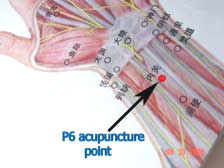 This study used Pericardium 6 (Neiguan) acupoint (photo) to reduce chemotherapy-induced nausea and vomiting.
This study used Pericardium 6 (Neiguan) acupoint (photo) to reduce chemotherapy-induced nausea and vomiting.
It raises as many questions as it attempts to answer.
First, the details.
- Patients were randomly assigned to acupressure applied using wristbands (Sea-Band) for the 5 days following chemotherapy or no acupressure.
- Results are based on 36 patients who completed the study.
And the significant benefits of acupressure.
- Less nausea and retching experience
- Less nausea, vomiting, and retching occurrence and distress
- But there was no difference in vomiting
The bottom line?
The reported benefits with acupressure and acupuncture to reduce nausea and vomiting have been summarized on this blog — here, here, and here.
But based on what’s presented in the abstract of this study, I have some questions.
- Why are the results limited to those who completed the study (and presumably had the best experience)?
- Would the findings be significant if all enrolled patients were evaluated (intent-to-treat group)?
- What was the difference in drug use between groups?
- It’s not clear why the symptom groupings were used? Why not just report differences in nausea, retching, and vomiting as individual outcomes?
My final question is why does a journal (Complementary Therapies in Medicine) that specializes in CAM research permit authors to write incomplete and misleading abstracts? It’s bad for the researchers’, and the journal’s reputation. And it’s a practice that raises doubt (whether justified or unjustified doesn’t matter) about the results. It makes it easy for critics of CAM to disregard the research.
5/12/07 20:42 JR